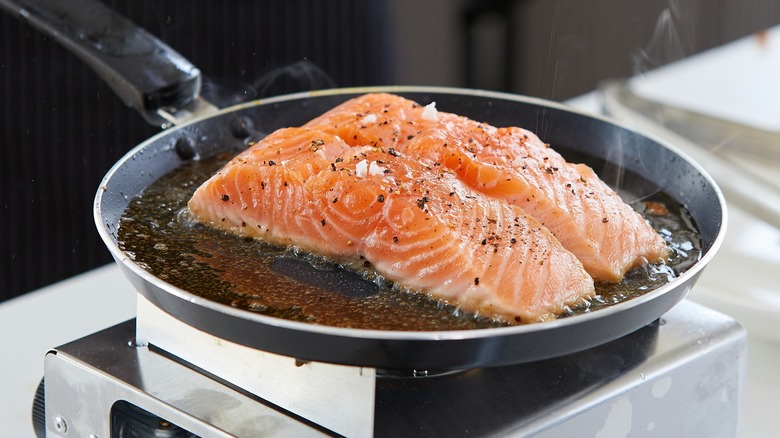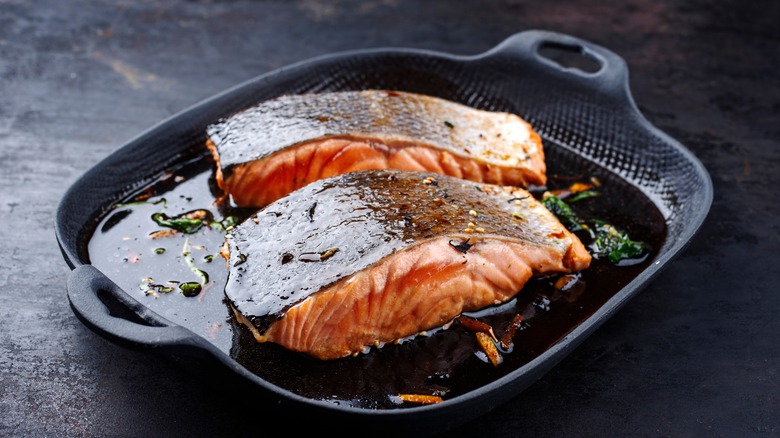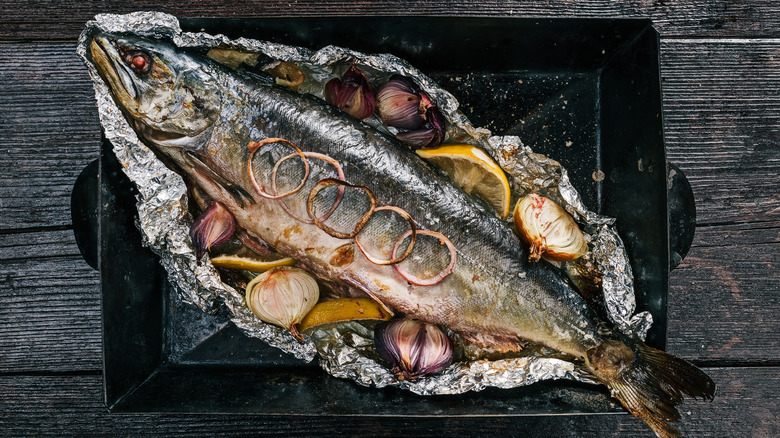The Gradient Tip For Perfectly Cooked Salmon Every Time
The mighty salmon, which miraculously swims for hundreds of miles upstream to ensure the survival of its offspring, was found in 2023 to be the most frequently consumed fish across the United States. When prepared appropriately, its rich, buttery flavor is unmatched, and its delicate, flaky texture is an absolute dream. Yet achieving perfectly cooked salmon every time can be a challenge. Never fear; with a simple lesson on achieving the correct gradient of color, you can consistently enjoy the tastiest salmon.
While the secret to crispy pan-seared salmon is in the skin, the color of the salmon portion deserves as much attention. When pan-frying salmon, the filet's color slowly changes from a slippery, translucent pink to a solid, opaque shade. Just like an egg's translucent white turns to crisp ivory, viewing the salmon from a side-on perspective should reveal the changing shades as the fish transitions from raw to cooked. Carefully observing fish as its color changes allows you to tell when it's cooked to perfection.
Say goodbye to the days of overcooked or dry-to-the-bone salmon. This tip will change the fish cooking game.
Using the gradient as a guide
When pan-frying salmon, begin skin side down and cook until the opaque gradient line, which indicates the salmon is cooked, has reached the middle of the cut of fish. Then, flip the fish over and follow the line on the other side. Ideally, you want a slightly lighter color on the halfway mark as this indicates the fish is still moist inside — instead of dry. To make the flip effortless and avoid the skin sticking to the pan, cook the salmon on top of a sheet of baking paper. You still get the famed crispy skin without the risk.
Salmon cooks extremely fast, and it's best to keep full attention on the fish once it hits the pan. If this is not possible, set a timer for 2 or 3 minutes for each side. Naturally, thinner pieces of salmon, such as the tail, will fry faster, while meatier chunks will take slightly longer.
Salmon can vary in color, from white to pink, orange to red. The slightly wet sheen of their raw color will harden and solidify, becoming nontransparent once the salmon cooks. If you've noticed a white substance seeping from the fish flakes, do not worry. This is albumin, a protein naturally occurring inside the fish. When exposed to heat, it is compressed to the surface. It is entirely natural and safe to consume.
When the color isn't obvious
The changing of gradient colors is not always apparent, and this may be impacted by the cut of salmon or the way it is being prepared. For instance, if the salmon is poached or baked inside foil, the exterior color may resemble the solid opaque pink or orange hue, indicating it's cooking completely. Yet, its interior may well still be raw and even cold. The simplest way to check if it's ready is to press down on the fish, and if it gently separates into flaky pieces, it's ready.
However, if you happen to be roasting a whole fish or wish not to break a portion in half with this previous tip, you can easily use a cake tester or butter knife to check the temperature instead. Insert the tester or knife into the thickest part of the fish and then press it on the back of your wrist. When the tester feels warm, the fish is cooked just right. Alternatively, you can use a kitchen thermometer and ensure the fish has reached an internal temperature of 145 degrees Fahrenheit.
Achieve salmon perfection by gauging its doneness from translucent to solid colors. It's an easy, direct method that ensures a flawless filet every time.


